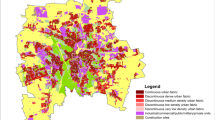Abstract
Accurate postal code maps have many applications within GIS as the postal code has the potential to link the address description of buildings to their location in a specified global reference system in a more natural way. This relationship is possible in both directions: geocoding and reverse-geocoding. These operators demand a mechanism for translating an exact geometric position (i.e. WGS84 coordinate) into a location indication (town, street, house number) and vice versa. As most built-up parcels are provided with a postal code, this indicator can be used as the linkage. This paper describes the procedure, based on the Dutch cadastral registration, to obtain a reliable 6-position (i.e. 2628BX, the highest level of detail possible) planar postal code map for the Netherlands. Problems with existing, Voronoi-diagram based, postal code maps, like intersected houses and arbitrary derived (and thus unrecognizable) boundaries are avoided. The reliability of the derived planar postal code map is discussed and results are illustrated by figures. For a planar coverage, non built-up parcels having no postal code should be assigned a plausible postal code. Furthermore special attention is given to infrastructural parcels. These parcels are divided at their (approximated) skeletons first and then these subdivided infrastructure parcels are piecewise attached to their neighbour parcels. This new approach results in very reliable postal code maps, which are visually attractive too as infrastructure lines can be recognized. The procedure is generic and can be applied to other administrative parcel information as well. The algorithm is implemented using the Computational Geometry Algorithms Library (CGAL), and the possibilities and limitations of this library are addressed as well. Also a number of non-implemented alternatives or improvements are given.
Similar content being viewed by others
References
CGAL Basic library manual. CGAL Consortium, 2002.
R. Chithambaram, et al. “Skeletonizing polygons for map generalization,” In: Technical papers, ACSM-ASPRS Convention, Cartography and GIS/LIS, Volume 2. Bethesda: ACSM, 44–54, 1991.
A. DeLucia and T. Black. “A comprehensive approach to automatic feature generalization,” in Proceedings of 13th International Cartographic Conference, International Cartographic Association, pp. 169–191, 1987.
A. Fabri, et al. On the design of CGAL, the Computational Geometry Algorithms Library (research report). Saarbrücken: Max-Planck-Institut für Informatik, 1998.
P. Gao, and M.M. Minami. “Raster-to-vector conversion: A trend line intersection approach to junction enhancements,” in Auto-Carto Vol. 13:298–303, 1997.
C.B. Jones, et al. “Map generalization with a triangulated data structure,” Cartography and Geographic Information Systems, Vol. 22–4:317–331, 1995.
P.J.M. van Oosterom. “Hartlijnen van wegennetwerken.” Informatieblad Kadaster, Vol. 7:10–11, 1999 (in Dutch).
P.J.M. van Oosterom, B. Maessen and C.W. Quak. “Generic query tool for spatio-temporal data,” International Journal for Geographical Information Science, Vol. 16–8:713–748, 2002.
F. Penninga, E. Verbree, C.W. Quak and P.J.M. van Oosterom. “Construction of the Planar Partition Postal Code Map Based on Cadastral Registration,” Proceedings of the Eleventh ACM International Symposium on Advances in Geographic Information Systems, November 2003, New Orleans, USA
J.R. Shewchuk. “Triangle: Engineering a 2D Quality Mesh Generator and Delaunay Triangulator,” In First Workshop on Applied Computational Geometry, Philadelphia, Pennsylvania, USA, MAY 1996, pp. 124–133.
T.G. Schut, en B. Maessen, Haalbaarheid. 6PPC-vlakkenkaart (eindrapportage). Apeldoorn: Kadaster, 2000 (in Dutch).
F. Thomas. “Generating street center-lines from inaccurate vector city maps”. Cartography and Geographic Information Systems, Vol. 25–4:211–230, 1998.
H. Uitermark, A. Vogels, and P. van Oosterom. “Semantic and geometric aspects of integrating road networks,” in A. Vckovski et al. (Eds), Interoperating Geographic Information System: Second International Conference, INTEROP ‘99, Berlin: Springer-Verlag, 117–188, 1999.
A. N. Wilschut, R. van Zwol, N. Brasa, J. Flokstra. “Road collapse in magnum,” in R. Laurini, (Ed.), 6th ACM Workshop on Advances in Geographic Information Systems ACM-GIS’98, Washington DC, USA, 6–7 November 1998.
Author information
Authors and Affiliations
Corresponding author
Rights and permissions
About this article
Cite this article
Penninga, F., Verbree, E., Quak, W. et al. Construction of the Planar Partition Postal Code Map Based on Cadastral Registration. Geoinformatica 9, 181–204 (2005). https://doi.org/10.1007/s10707-005-6430-3
Received:
Revised:
Accepted:
Published:
Issue Date:
DOI: https://doi.org/10.1007/s10707-005-6430-3




